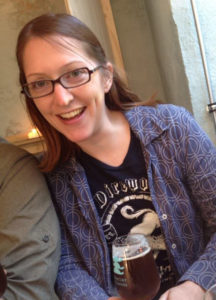Lisa Grimm
An extensive literary history and programing background, Grimm understands the importance of a strong taxonomy and the value of an open-mind with all things DAM.
What companies/organizations have you worked for as a DAM professional? What was your role at each?
I’m presently the Content Librarian at GSK, where I oversee the (relatively-newly-launched) DAM for marketing materials. Highlights of previous DAM-related roles include a stint as Content Manager for the NYC Department of Health and a very enjoyable time at Drexel University College of Medicine, where I worked with an outstanding collection of historical materials on women in medicine that is still being digitized, though I’m proud to say I got them started blogging as well.
I’ve also spent many years ‘managing’ content without any sort of DAM, so I know the chaotic side of things too – starting in the 1990s, I built and managed websites for companies like Time Out in London and Women.com in Silicon Valley (among many others) back when we had to hand-code everything and store our images in complicated folder structures, both on and offline, so I know the value of having a solid DAM!
How do you describe digital asset management to others?
I try to break it down into its constituent parts: I oversee content coming into the system and ensure that it is findable by attaching appropriate metadata – at that point I usually do a brief explanation of metadata and taxonomy that might be more usefully employed as a sleep aid. What I tend to leave out are the more complex product and change management pieces of my role, but I do like to compare notes about those aspects with other DAM professionals.
How did you learn DAM? Any recommended sources?
After years of hand-coding and putting files in random locations, the online industry finally began to realize that it might be more useful to have their images, audio, video and other files in some more manageable system, and as a web manager, I was asked to evaluate a number of software solutions in the early days of both DAM and web content management.
As I moved into other jobs, I worked on a variety of platforms – some homegrown, some purchased – and learned as I went along. I later went back to library school for my MS-LIS, which gave me more grounding on the taxonomy and knowledge management side of the fence. All of it has been useful in one mode or another, so my advice is to keep an open mind and learn from a variety of sources.
If you weren’t doing DAM as a career, what would you be doing?
My other degrees are in archaeology and I’ve worked a lot with museums, archives and rare books, but I’d hate to give up the technology piece; as much as I do love my current company, in an ideal world, I’d probably be running a DAM for the British Museum or the Bodleian Library. I also do a bit of freelance writing when I have time, but it’s always been a sideline; I don’t have the time or patience to develop it into a full-time career, though there’s probably a (non-fiction) book or two in there somewhere that might come out eventually.
What is your ongoing greatest challenge with DAM?
User adoption of a new system and building a longer-term roadmap are always the tricky parts – change management is just as important as having a solid taxonomy.
What is your vision for DAM? What will it look like in 5 years?
The challenges of managing text-based content and working more from a content strategy framework are always front of mind for me; while there are other tools that can manage structured content very well indeed, we need to consider integration with the DAM and what that will look like – not to mention the additional challenge of dealing with great volumes of utterly unstructured content. I’d love to see DAM tools reflect (or perhaps ‘reinforce’ is the better word) the content life cycle; content governance is important, but it’s easy to push off until ‘later’ without built-in encouragement.
This interview originally appeared on DAM Guru on Mon, 25 Nov 2013. For more DAM News interviews, see the interviews index page.
Share this Article:

